Geometry | Term 1 Chapter 5 | 7th Maths - Transversal | 7th Maths : Term 1 Unit 5 : Geometry
Chapter: 7th Maths : Term 1 Unit 5 : Geometry
Transversal
Transversal
Observe the Fig.5.13. Here m and n are any two non-parallel lines and l is another line intersecting them at A and B respectively. We call such intersecting line (l) as transversal. Therefore, a transversal is a line
that intersects two lines at distinct points. We
can extend this idea to any number of lines.
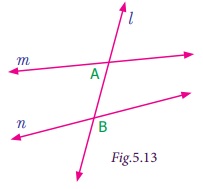
Now observe the following Fig.5.14. Check whether
the line l is transversal to other line
in both the cases (i) and (ii).
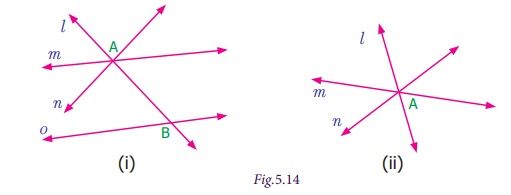
Think
For a given set of lines, is it possible
to draw more than one transversal?
In figure (i) the line l is not a transversal to the lines m and n, but it is a transversal to the pair of lines m and o , n and o.
In figure (ii) l does not intersect the lines m and n at distinct points. So, it is not a transversal.
Try these
1. Draw as many possible transversals in the given figures.

(i) p, q, r, s, t and u are the transversals of l and n
(ii) a, b, c and d are the transversals of m and p c, d, e, f, g, h and i are the transversals of l and n.
2. Draw a line which is not the transversal to the above figures.
m is not the transversal of l
and n
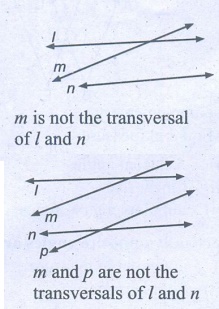
m and p are not the
transversal of l and n
3. How many transversals can you draw for the following two lines?


Un countable transversals can be drawn for the following two
lines.
1.
Angles formed by a transversal
If a transversal meet two lines, eight angles are
formed at the points of intersection as shown in the Fig.5.15.
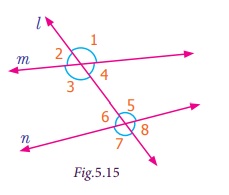
It is clear that the pairs of angles ∠1, ∠2, ; ∠3, ∠4, ; ∠5, ∠6 and ∠7, ∠8 are linear pairs. Can you find more linear pairs
of angles?
Besides, the pairs ∠1, ∠3 ; ∠2, ∠4 ; ∠5, ∠7 and ∠6, ∠8 are vertically opposite angles.
We can further classify the angles shown in the
Fig. 5.15 into different categories as follows.
Corresponding angles
Observe that the pair of angles ∠1 and ∠5 that are marked at the right side of the transversal
l. In that ∠1 lies
above the line m and ∠5 lies above the line n.
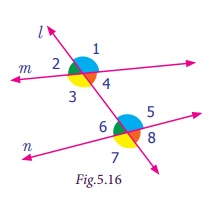
Also observe the pair of angles ∠2 and ∠6 that are marked on the left of the transversal l. In that ∠2 lies above m and ∠6 lies above n.
In the same way observe the pair of angles ∠3 and ∠7 that are marked on left of transversal l. In that ∠3 lies
below m and ∠7 lies below n.
Observe the pair of angles ∠4 and ∠8 that are marked on the right of transversal l. In that ∠4 lies
below m and ∠8 lies below n.
So all these pairs of angles have different vertices,
lie on the same side (left or right) of the transversal(l), lie above or below the lines m and n. Such pairs are called corresponding angles.
Alternate Interior angles
Each of pair of angles named ∠3 and ∠5, ∠4 and ∠6 are marked on the opposite side of the transversal
l and are lying between lines m and n are called alternate
interior angles.
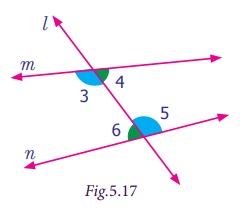
Alternate Exterior angles
Each pair of angles named ∠1 and ∠7, ∠2 and ∠8 are marked on the opposite side of the transversal
l and are lying outside of the lines m and n are called alternate exterior angles.
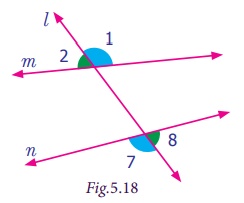
Now let us observe some more pairs of angles.
Each pair of angles named ∠3 and ∠6, ∠4 and ∠5 are marked on the same side of transversal l and are lying between the lines m and n. These angles are lying on the interior of the lines
m and n as well as the same side of the transversal l.
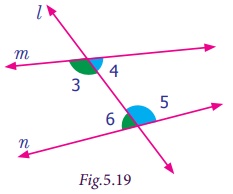
Each pair of angles named ∠1 and ∠8, ∠2 and ∠7 are marked on the same side of transversal l and are lying outside of the lines m and n. These angles are lying on the exterior of the lines m and n as well as the same side of the transversal l.
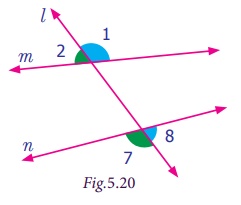
How can we call such angles?
We call them as co-interior and co-exterior angles.
In Architecture, corresponding angles are used to assure
symmetry and balance when designing the structure. Alternate exterior angles
are used to ensure symmetry in floor plans. Alternate interior Angles are
used to ensure that two beams are parallel and do not let the structure bend or
deform in any form.
Interior angles on the same side of
the transversal are used
to determine if two beams are parallel and will not result in any distractions to
the overall design. Exterior
angles on the same side of the transversal are used to confirm that the walls
are indeed straight and not at a different angle.
2.
Angles formed by a transversal with Parallel lines
We saw different types of angles formed by a transversal
while intersecting two given lines. Now let us observe some interesting facts on
the angles formed by a transversal with the parallel lines from the following activities.
Activity
Observe the marked pair of corresponding
angles in each figure. One in the interior and other in the exterior of the parallel
lines and both lie on the same side of the transversal. One pair of angles are measured
and found equal. Measure the remaining three pairs of angles and check.
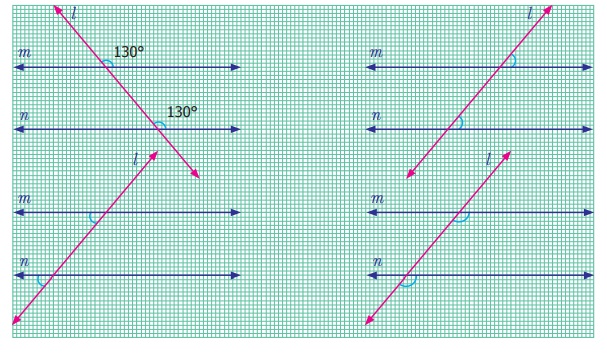
From the above activity, we can conclude
that when two parallel lines are cut by a transversal, each pair of corresponding angles are equal.
Try these
1. Four real life examples for transversal of parallel lines are
given below.

Give four more examples for transversal of parallel lines seen in
your surroundings.

2. Find the value of x
.

(i) x° = 125° (ii) x° = 48° (iii) x° = 138°
Activity
Observe the alternate Interior angles
in each figure. Both lying between the interior of the parallel lines and on the
opposite sides of the transversal. One pair of angles are measured and found equal.
Measure the remaining three pairs of angles and check.
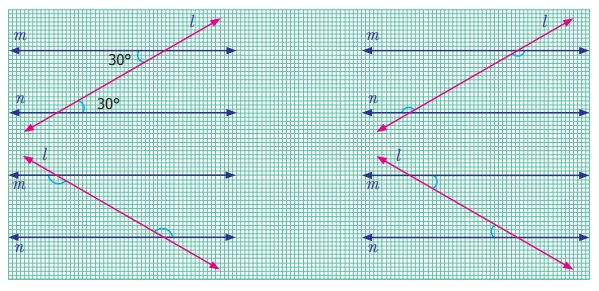
From the above activity we can conclude
that when two parallel lines are cut by a transversal, each pair of alternate interior angles are equal.
Activity
Observe the marked alternate Exterior
angles in each figure. Both lying at the exterior of the parallel lines and on the
opposite sides of the transversal. One pair of angles are measured and found equal.
Measure the remaining three pairs of angles and check.
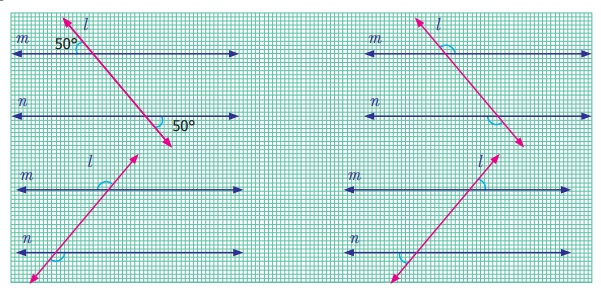
From the above activity we can conclude
that when two parallel lines are cut by a transversal, each pair of alternate exterior angles are equal.
Try these
Find the value of x°.
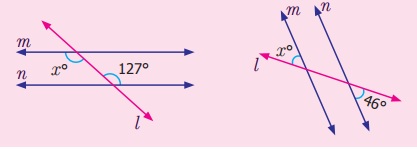
(i) x° = 127° (ii) x° = 46°
Activity
Observe the marked co -interior angles in each figure. Both lying between
the interior of the parallel lines and on the same side of the transversal. One
pair of angles are measured and found the sum to be 180°. Measure the remaining
three pairs of angles and check.
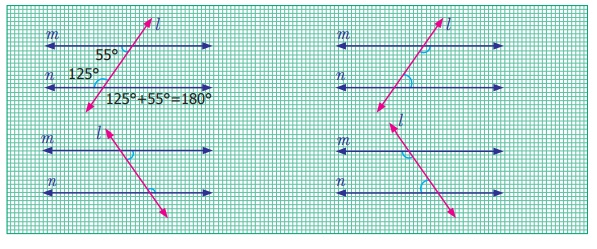
From the above activity we can conclude
that when two parallel lines are cut by a transversal, each pair of interior angles that lie on the same side of the
transversal are supplementary.
Activity
Observe the marked co-exterior angles in each figure. Both lying at the
exterior of the parallel lines and on the same side of the transversal. One pair
of angles are measured and found that they are supplementary. Measure the remaining
three pairs of angles and check.
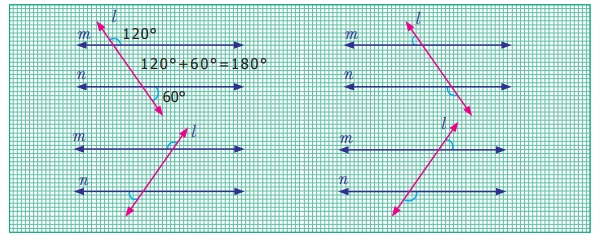
From the above activity we can conclude
that when two parallel lines are cut by a transversal, each pair of exterior angles that lie on the same side of the
transversal are supplementary.
Try these
Find the value of x .
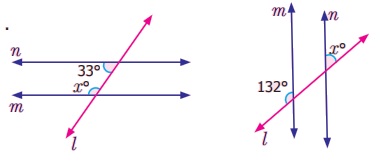
(i) x°= 180 – 33° =
144°
(ii) x° =
180 –132° = 48°
Example 5.8
(i) Name the angle that corresponds to ∠1.
(ii) Name the angle that is alternate interior to
∠3.
(iii) Name the angle that is alternate exterior
to ∠8.
(iv) Name the angle that corresponds to ∠8.
(v) Name the angle that is alternate exterior to
∠7.
Name the angle that is alternate interior to ∠6.
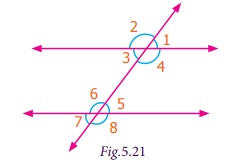
Solution
(i) The angle that corresponds to ∠1 is ∠5
(ii) The angle that is alternate interior to ∠3 is ∠5
(iii) The angle that is alternate exterior∠ to ∠8 is ∠2
(iv) The angle that corresponds to ∠8 is ∠4
(v) The angle that is alternate exterior to ∠7 is ∠1
(vi) The angle that is alternate interior to ∠6 is ∠4
Example 5.9
(i) Which angles are corresponding angles to b°?
(ii) What is the measure of b°?
(iii) Which angles have the measure 68°?
(iv) Which
angles have the measure 112°?
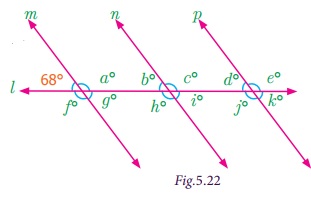
Solution
(i) The corresponding angles to b° are d° and 68°.
(ii) The measure of b° is 68° (Because b° corresponds to 68°)
(iii) The angles having measure 68° are b°, d°, g°, i° and k°.
(iv) The angles having measure 112° are a°, c°, e°, f°, h° and j°.
Example 5.10
If l is parallel to m, find the measure of x and y in the figure.
Solution
Given l is parallel to m and n is transversal to l and m.
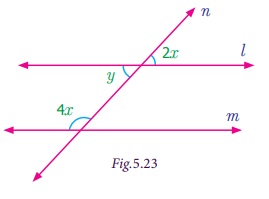
We get, y = 2x [Vertically opposite
angles are equal]
y + 4x = 180° [sum of interior angles that lie on
the same side of the transversal]
2x + 4x = 180° [since y = 2x]
6x = 180°
Dividing by 6 on both sides
x/6
= 180°/6 gives, x = 30°.
Now, y =
2(30°) = 60°.
Related Topics